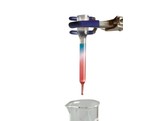Ion exchange chromatography (IC) is a way of separating and analysing substances on the basis of their ionic properties.
Substances with a low charge density (e.g. bromide) are retained longer and can thus be separated from substances with a high charge density (e.g. fluoride). Most molecules have a net charge within a pH range of 2 to 10. If the pH is changed, the net charge of the molecules can change dramatically.
In this experiment a mixture of two chemicals is absorbed into an ion exchange column and separated during an elution under conditions that affect the net charge.
The kit contains: ion exchange column, potassium acetate buffer, blue and red dye, chromatography columns, pippettes and tubes.
Also required: photo spectrometer, cuvettes, laboratory standards and clamps, test tubes. Lab glassware and distilled water, 5 ml pipettes.
Substances with a low charge density (e.g. bromide) are retained longer and can thus be separated from substances with a high charge density (e.g. fluoride). Most molecules have a net charge within a pH range of 2 to 10. If the pH is changed, the net charge of the molecules can change dramatically.
In this experiment a mixture of two chemicals is absorbed into an ion exchange column and separated during an elution under conditions that affect the net charge.
The kit contains: ion exchange column, potassium acetate buffer, blue and red dye, chromatography columns, pippettes and tubes.
Also required: photo spectrometer, cuvettes, laboratory standards and clamps, test tubes. Lab glassware and distilled water, 5 ml pipettes.
Properties
- F778243

